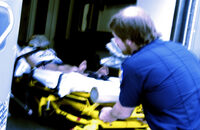 A cardiac arrest happens when a person's heart stops pumping blood around their body, their breathing stops and oxygen is no longer circulating. There are approximately 60,000 out of hospital Sudden Cardiac Arrests (SCA) each year in the UK, and they can affect anyone, regardless of age, gender or lifestyle.
A cardiac arrest happens when a person's heart stops pumping blood around their body, their breathing stops and oxygen is no longer circulating. There are approximately 60,000 out of hospital Sudden Cardiac Arrests (SCA) each year in the UK, and they can affect anyone, regardless of age, gender or lifestyle.
SCAs are life threatening; without immediate treatment, 90 to 95% of cardiac arrest victims will die.
Every good employer knows how important the wellbeing of their staff members is, but may not be aware of the benefits of having a defibrillator in the workplace.
If a defibrillator is used within 3 to 5 minutes of a person suffering a cardiac arrest, their chances of survival increase from 6% to 74%. With the average emergency services response time in an urban area recently increasing to 11 minutes for cardiac arrests, the importance of having access to a defibrillator cannot be underestimated.
What is a defibrillator?
A defibrillator is a device that administers an electric shock to allow the heart to restart its natural rhythm. The only effective treatment for someone who has an SCA is the combination of cardiopulmonary resuscitation (CPR) and the use of a defibrillator.
There are different types of defibrillator models available for different environments, and they each come with built in fail-safes to ensure that they will never shock someone who does not need to be shocked. Defibrillators can be used on all adults, and there is specific defibrillator equipment available for children.
The benefits of having a defibrillator in the workplace
When someone has a cardiac arrest, every minute without CPR and defibrillation reduces their chances of survival by 7-10%. Defibrillators are a potentially lifesaving piece of equipment to have in a workplace, and their importance should not be underestimated.
Different types of defibrillators can be purchased for different types of workplaces, and there are even special machines available for schools and public places.
Equipping a workplace with the right tools, including a defibrillator could prevent a possibly fatal incident.
How to use a defibrillator
If a person has a sudden cardiac arrest, people near the accident will need to act quickly. After calling 999, basic life support will need to be administered to the patient to keep the blood and oxygen pumping around their body and to help keep their brain alive until help arrives.
The next step is to access the defibrillator. Anyone can use a defibrillator in an emergency, even if they have had no formal training. Contrary to popular belief, these machines are designed to be as easy as possible to use.
Once the machine is turned on, the pads provided must be taken out of the packet and applied to the patient's bare chest. From then, the defibrillator will offer visual or vocal prompts advising of the next steps, and the machine will analyse what rhythm the patient's heart is in.
If a patient is in cardiac arrest, the person using the defibrillator will be told to deliver a shock to the patient's heart to restart its natural rhythm, simply by pressing a button. A defibrillator will only ever administer a shock to someone who is in cardiac arrest; they will never shock a live patient. There is no need for anyone using the defibrillator to be scared of hurting the patient as the machine will not make a mistake.
Author bio
Rosa Mitchell is a guest blogger from defibshop, the UK’s leading independent defibrillator supplier.